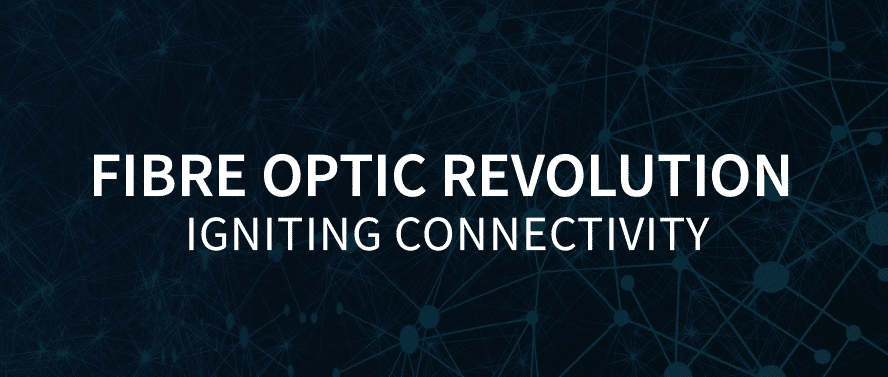Fibre Optic Revolution: Igniting Connectivity

The integration of fibre optic connectivity has emerged as a transformative force for businesses seeking to enhance their operational capabilities.
How fibre optic works?
At its essence, fibre optic technology involves the transmission of data through thin strands of glass or plastic fibres, utilising pulses of light. This innovative approach enables data to be transmitted at remarkable speeds, overcoming the limitations of traditional copper cables. The core components of a fibre optic system include the transmitter, the fibre cable, and the receiver.
This technology works like a superhighway for information, using tiny strands of glass or plastic to send messages at the speed of light. Imagine each strand as a light pipe that carries beams of light, representing your emails, videos, and calls. These light signals zip through the fiber, much like whispers through a secret tunnel.
So, when you’re streaming a movie or chatting on a video call, it’s like sending beams of light racing through these special tubes, allowing you to experience a smooth and fast connection. It’s like magic – instant, reliable, and bringing the world to your fingertips faster than ever!
Types of Connectivity
1. Fibre-To-The-Premises (FTTP):
In FTTP, the fibre optic cables extend directly to individual businesses or residences, providing end-to-end connectivity. This guarantees maximum speed and reliability, as there is no copper involved in the last mile of the connection.
Imagine FTTP as a direct delivery service for your internet. It’s like having a special highway made of super-fast glass or plastic cables that go straight from the internet provider to your home.
With FTTP, you get the fastest and most reliable internet experience because the magic internet highway comes right to your doorstep. It’s like having a private road just for you, ensuring that all your online activities happen at lightning speed.
2. Fibre-To-The-Cabinet (FTTC):
FTTC is like a combo of fast and traditional. Instead of the internet highway going directly to your home, it stops at a neighborhood cabinet first.
Think of the cabinet as a hub for your local area. From there, regular cables (copper wires) bring the internet the final stretch to your home. It’s like having a fast train that brings most of the speed to your neighborhood station, and then a local delivery truck (copper wires) brings it the last bit to your house.
Benefits of Fibre Optic Connectivity
1. Unparalleled Speed and Bandwidth:
One of the primary advantages of fibre optic connectivity is its unmatched speed. With data transmitted at the speed of light, British businesses can enjoy faster internet access and seamless data transfer, fostering increased productivity and efficiency.
2. Reliability and Consistency:
Fibre optic cables are less susceptible to external interference and environmental factors, ensuring a more reliable and consistent connection. This is especially crucial for British businesses that rely on a stable internet connection for day-to-day operations.
3. Scalability for Growing Demands:
Fibre optics provide scalability, allowing British businesses to effortlessly scale up their connectivity infrastructure as their data requirements expand. This adaptability ensures that the network can grow in tandem with the business, preventing bottlenecks and slowdowns.
4. Enhanced Security Measures:
Fibre optic connections offer increased security, as they are more challenging to tap into without detection. This heightened level of security is invaluable for British businesses handling sensitive information, safeguarding against potential cyber threats.
5. Future-Proofing Your Business:
Investing in this technology is a forward-thinking strategy. As technological advancements continue to unfold, British businesses with fibre optic connectivity are well-positioned to seamlessly adopt emerging technologies, such as IoT, AI, and other data-intensive applications.
6. Improved Collaboration and Remote Work:
The high-speed and reliable nature of fibre optics facilitate smoother communication and collaboration, which is particularly crucial in the era of remote work. Video conferencing, file sharing, and other collaborative tools become more efficient and seamless.
Fiber optic connectivity stands as a cornerstone for modern businesses, offering a transformative impact on their operations and competitiveness. The exceptional speed at which data travels through fiber optic cables plays a crucial role in addressing the challenges posed by the current digital environment. Fiber optic connectivity’s fast and reliable communication infrastructure allows businesses to effortlessly manage large data loads, enhancing day-to-day efficiency. Whether facilitating instant collaboration, high-quality video conferencing, or swift access to cloud-based applications, its flexibility is essential for businesses to meet the dynamic demands of the modern market.
At Twisted Pair, our dedication lies in delivering tailored fiber optic solutions for your business. Through our array of esteemed product partners, we’re equipped to fulfill diverse requirements. We prioritize integrity in offering precise evaluations of our clients’ network necessities. Reach out to us for further insights on how our company can assist with your fiber installation requirements.
